
| Accueil | |
Dickson 1930 | |
|
Le
Dickson est un planeur anglais de début,
dessiné en 1930 par Roger S. Dickson. L'approche technique et la
diffusion des plans sont exemplaires de l'état d'esprit qui régnait
dans le monde du vol à voile à l'époque et du rôle qu'ont pu jouer les
revues pour
la promotion du vol sans moteur, en direction des clubs mais aussi des
constructeurs amateurs
particuliers. La description détaillée de ce planeur ainsi que des
conseils de construction ont été publiés dans la revue Flight entre
décembre 1929 et août 1930. Les plans étaient en vente à la revue. COMPILATION CHRONOLOGIQUE DES ARTICLES | |
| [Flight 20 décembre 1929, pages 1328-1329] [1929-1 – 1889 et 1929-1 - 1890] | |
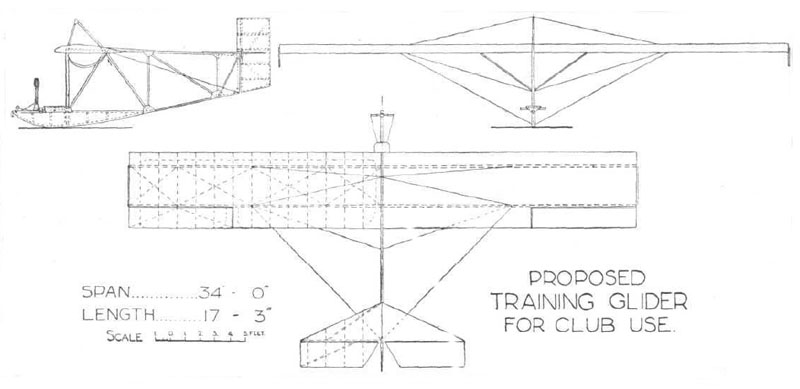 | |
| Above
we illustrate a training type of glider which has been designed by Mr.
R. S. Dickson, of Southampton. We have recently received a number of
enquiries from those who wish to build, or at least to look into the
possibilities of building, a glider, and there seems to be a lack of
literature on the subject. For such enthusiasts the machine illustrated
above may be the thing they are looking for, and with this idea in view
we propose to publish further constructional details at an early date. Mr. R. S. Dickson writes : There is no doubt that the sport of gliding is at last coming into its own in this country. Events of the last few months have shown that there are a large number of people from all walks of life who are intensely interested in the human imitation of soaring birds. During the gales that have swept over the country of late, there have been many opportunities of witnessing that most beautiful spectacle of gulls hovering over a building or bridge apparently without effort, and one must be very weak-blooded if one does not feel at least a momentary desire to be with them. The feeling is so genuine that, as with many other intimate thoughts, one is rather apt to be slightly ashamed of it, and tries to cover up the apparent weakness with a jest. At the present time, however, enthusiasts are meeting together in several parts of the country with a view to forming gliding clubs, and one very good sportsman has offered to pay for two or three machines to help things along. It is probable that in the near future some of these clubs will be satisfactorily started, in some instances as branches of the existing aeroplane clubs. There is a feeling that ordinary club flying tends to become rather boring, and although interest is kept up to a certain extent by means of competitions and meetings the average member would welcome something different. As a sport gliding has few equals, the combination required of a knowledge of air currents'with quickness of thought, and gentleness of handling the controls, can only be compared with the art of yachting. One of our best-known aeroplane pilots was heard to remark the other day that he never had quite the same feel of the air with modern aeroplanes that he had with the old Brooklands machines before the war, which were more like engined gliders than anything else. He thought that a glider should give him the old feeling again, and he is impatient to try one. Gliding has been practised spasmodically for very many years in this country, but the problem was not seriously attacked until after the war when the astounding results obtained by German experiments in the Rhön mountains during 1920 and 1921 began to interest other countries, notably France and England. In France a meeting was held at Combegrasse, and in England we had a very interesting week at Itford Hill and Firle Beacon, near Lewes, Sussex. The French pilot, the late M. Maneyrol, succeeded at the Itford meeting in remaining in the air for 3 hrs. 21 mins. 7 secs, in a Peyret tandem monoplane glider, thereby beating the previous " record " held by Germany. After this, however, despite the encouragement given to gliding by the FLIGHT Glider Design Competition, the movement was practically dropped in this country, chiefly owing to the fact that the aircraft firms did not feel justified in spending money on a sporting venture of this nature, and there were unfortunately few people capable of carrying out design and construction work outside the aircraft industry. During the period between the Itford meeting and the present day, Germany has gradually improved her gliding facilities so that many boys' schools now have their gliding club, and one club has been formed which is composed entirely of women. The Germans are at present far ahead of any other nation in the matter of engineless flying ; and it is, therefore, of interest to investigate their latest types of aircraft so that we do not repeat their old mistakes. There are two chief types of gliders—or sailplanes, as they are called—in Germany at the present time : the very cheap and simple training machine, and the high-efficiency gustsoaring machine. The first type is designed to be as cheap as possible to build and repair, and must be fairly stable in flight to suit beginners, who fly solo from the start, although, of course, the first flights are of only a few seconds' duration. This type can be built for about £20 by an amateur craftsman, and is the type that the clubs will require. In Germany one may purchase this simple form of machine for £43. The second type of glider is only flown by fairly experienced pilots, and although a good machine can be built for £25 the price may rise above £200. This great difference is due to the fact that the chief points required in this type are : light weight, and low drag, and in some machines the construction is very intricate and calls for the best possible materials and workmanship. When the clubs start flying, the most popular glider will be the cheap training type, the high performance machine only being suited to experts who will probably own their own pet machines. In any case every person must start on a training type ; even the best of pilots are not used to the light loading common to all gliders, and would have a little trouble at first. In view of these facts it is proposed to attempt to standardise the simple glider, and to this end the machine shown in the accompanying drawings has been designed. The construction throughout is extremely simple, and the average amateur should have no difficulty in completing the machine. This glider has been designed with high factors throughout, and is very robust. The estimated weight without pilot is 180 lbs., thus giving a wing loading of approximately 2 lbs. per sq. ft. with an average pilot. The landing speed is 22 m.p.h., so that in an ordinary light breeze the relative ground speed will only be about 7 m.p.h. The wing section used, the C Y.H., has a high maximum lift, low drag, and a fairly stable centre of pressure. External wire bracing is cheaper and simpler to repair than a pure cantilever wing, and there are no bracing wires inside the air surfaces, their place being taken by spruce strips. |
|
| [Flight 24 janvier 1930, pages 153] [1930-0153] | |
| Last
week we publish the drawings of the wing construction of the " Dickson
" glider. The general scheme has been to use just a few standard
sections of spruce, and thereby make the glider simple and inexpensive.
This method does not, of course, allow the use of the most economical
design, but the advantages gained for the purpose for which the glider
is intended, far outweigh the disadvantages. Further constructional
details will be published as soon as they are received. We have already had a considerable amount of
correspondence on this glider, and if there are any points which
readers are not clear about we shall endeavour to elucidate them. | |
De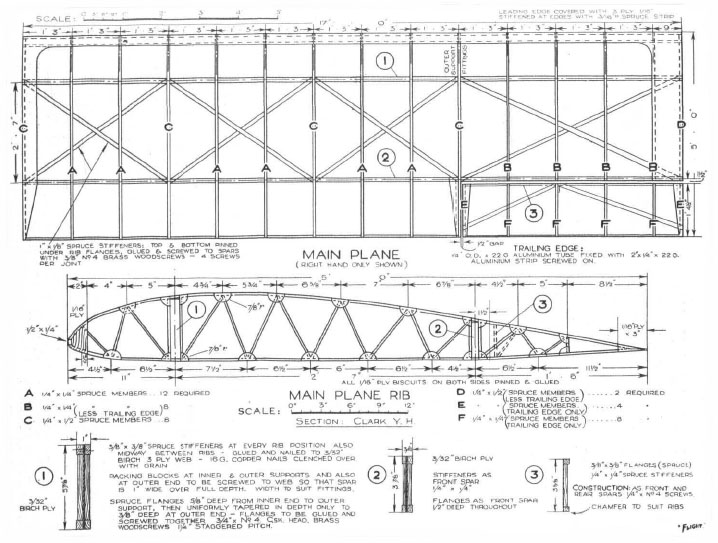 F-01 - Main plane and rib | |
| [Flight 31 janvier 1930, pages 168] [1930-0168] | |
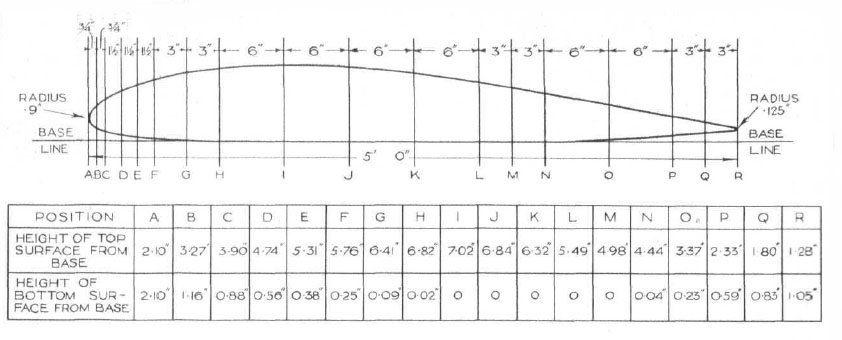 | |
| Above
we give the ordinates of the C.Y.H. aerofoil section laid, out on a
5-ft. chord, so that those who are constructing the Dickson Glider,
will have no difficulty in making up the ribs together with this and
last week's drawings. The factors which have been adhered to in the
design of this glider are actually somewhat higher than those suggested
by the Gliding Association, so constructors need have no fear on the
score of strength. A somewhat piquant situation is now possible as the
R.A.E. state that there are no official requirements for gliders and no
C. of A. (Certificate of Airworthiness) is required, but we are discussing this elsewhere in this
issue, as the importance of having this point made quite clear can
hardly be overestimated. Many enquiries have been received about this
glider, and we shall be glad to hear of any difficulties readers may
have in its construction. | |
| [Flight 14 février 1930, pages 218] [1930-0218] | |
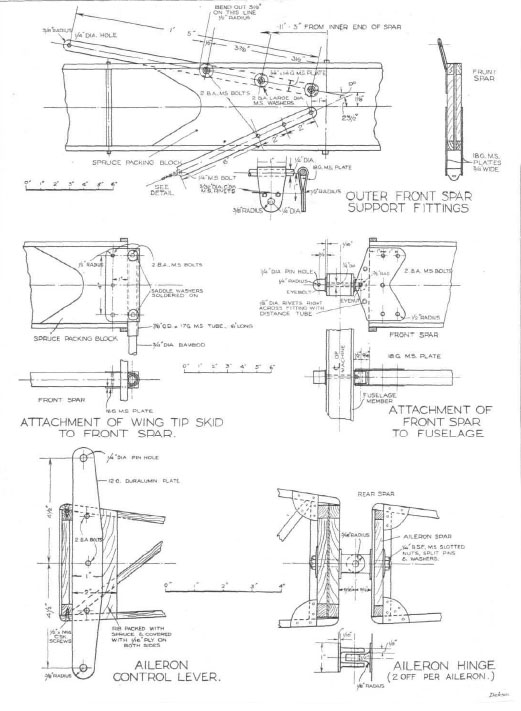 F-03 - Details | |
| This
week we give a few further details of the Dickson glider. To obtain
suitable material, we suggest that those who are constructing this
machine get in touch with the nearest aircraft manufacturer, who should
be willing to supply all the materials necessary and to the correct
specifications. This latter point is most important, as it should be
realised that all calculations for strength have been based on these
specifications, and the use of different material would most probably result in disaster. All nuts, pins, turn buckles,
etc., must be positively locked by locking wires or washers or similar
means. With regard to the wing spars, joints should be made in the
plywood web according to the length of the ply available ; a piece of
ply about 2 in. wide, glued and pinned to the web either side of the
joint would be sufficient. | |
| [Flight 7 mars 1930, pages 275] [1930-0291] | |
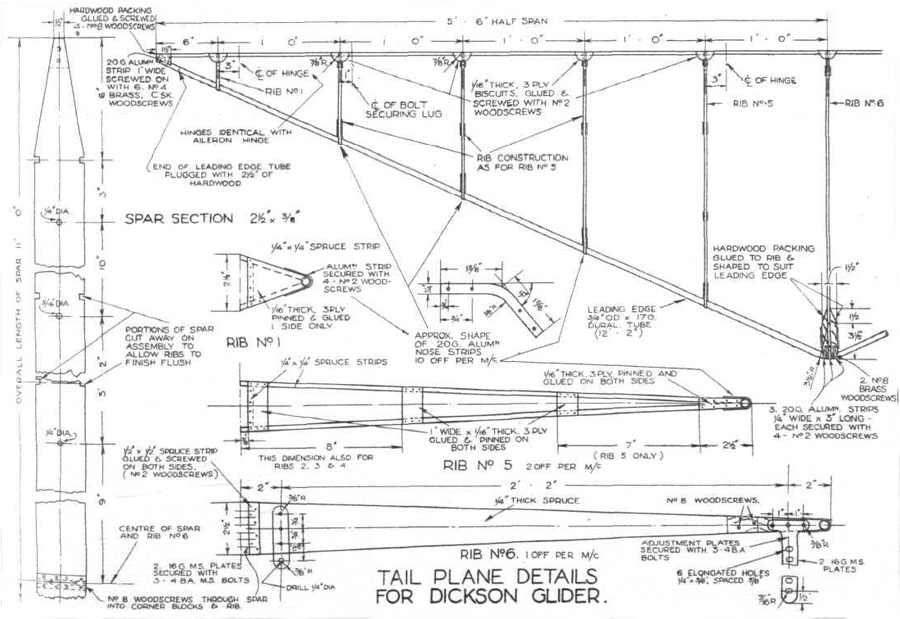 F-04 - A further set of details of the Dickson Glider. | |
| [Flight 14 mars 1930, pages 296 et 297] [1930-0312 et 0313] | |
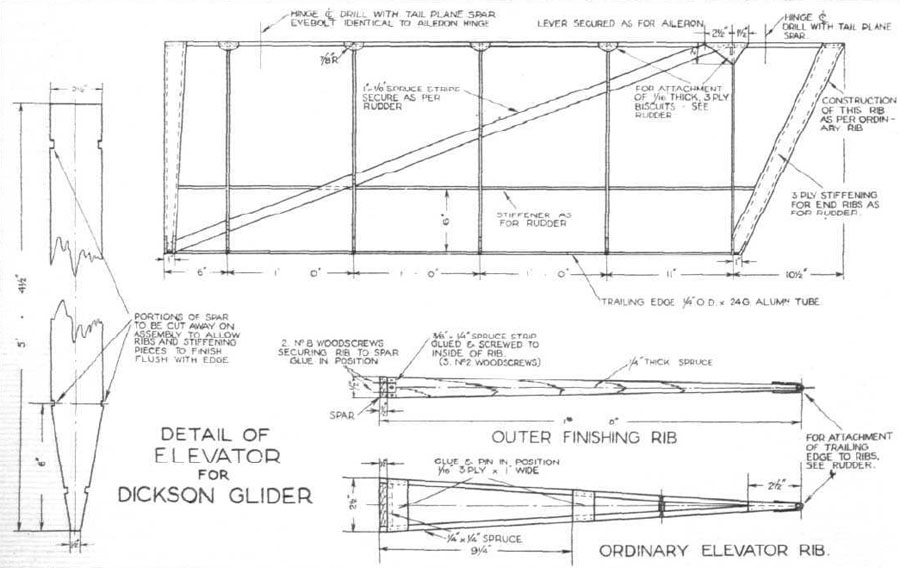 F-05 - The Dickson glider : Above are the details for constructing the elevators for the Dickson Glider. 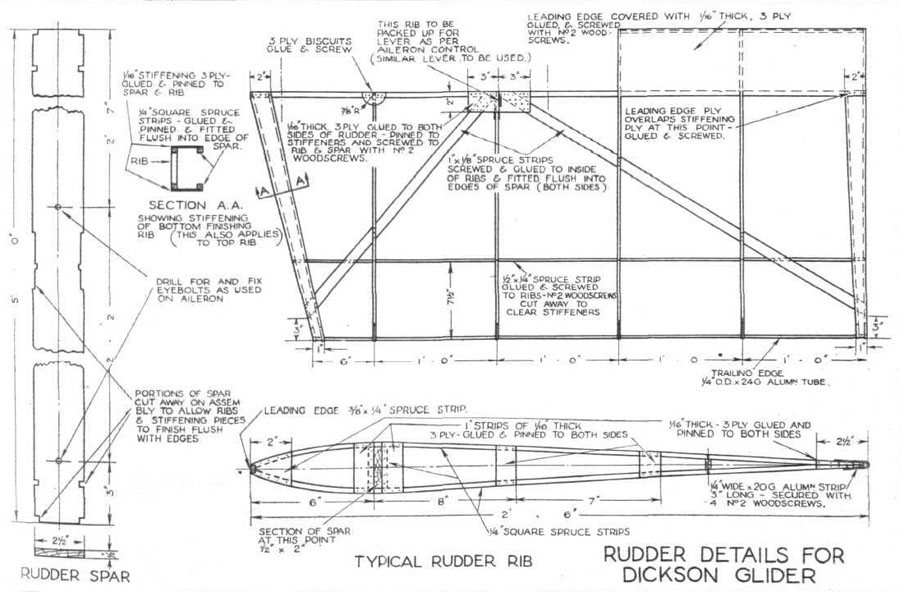 F-06 - The Dickson glider : Above are details for constructing the Rudder of the Dickson Glider. 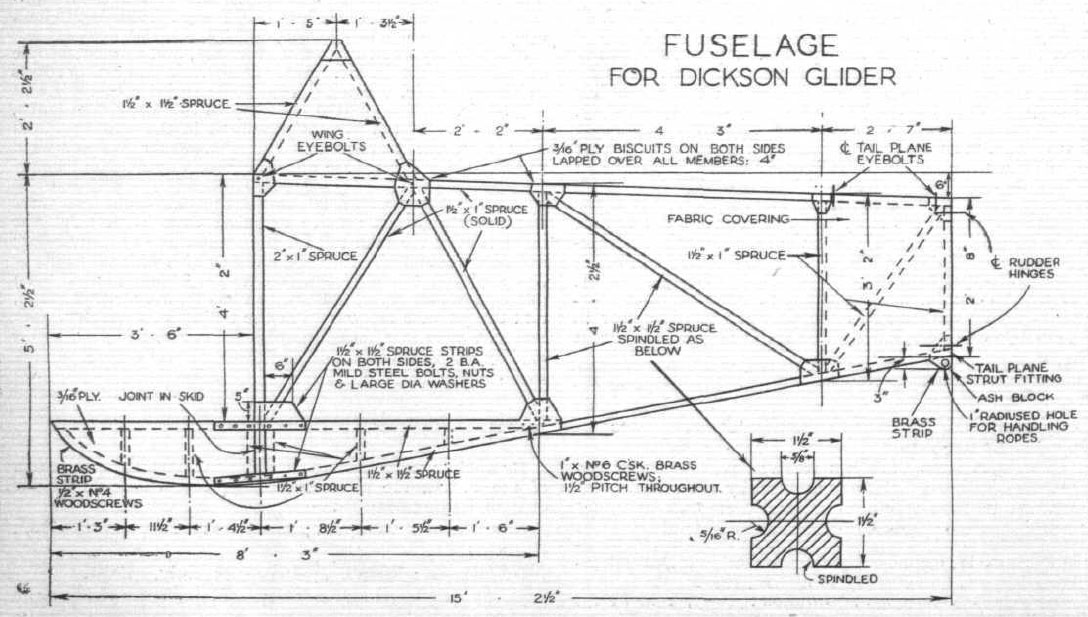 F-07 - The Dickson glider fuselage ; The above completes the major details of this glider.
[Flight 11 avril 1930, pages 419] [1930-0443] THE DICKSON GLIDER. Last week we published the drawing for the fuselage of this glider and, unfortunately, the designer has informed us that certain dimensions were erroneous. These were :—the front member should have been 2 in. by 1.5 in., and the top longeron and second two truss members should have been 1.5 in. by 1.5 in. The designer regrets that these errors were allowed to pass and hopes that no undue inconvenience has been caused to those building this glider. 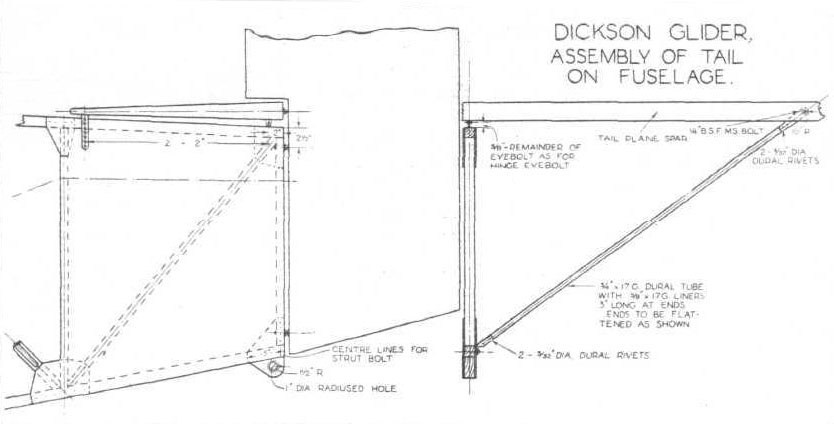 F-08 - This diagram shows how the tail plane is mounted on the fuselage.
[Flight 9 mai 1930, pages 512 et 513] [1930-0536 et 1930-0537] 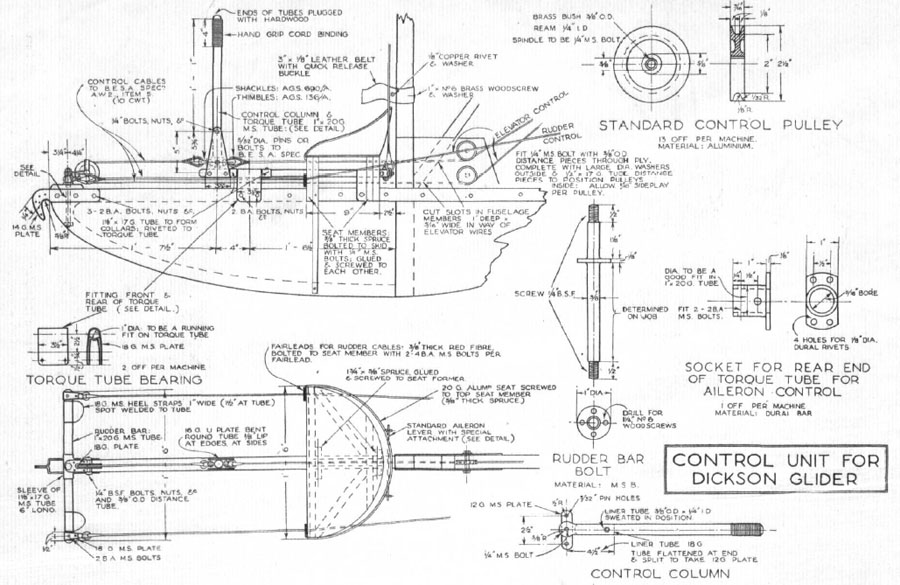 F-09 – Control unit This week we are able to
publish the controls of the Dickson Glider and on the following page
will be found a few notes referring to general details which should be
taken care of. Next week we hope to have ready the final drawings which
are the pulley mounting details and a general control wire G.A.
All surfaces should be varnished internally and painted at points where the fabric touches with non-sticking paint. On the main planes the ribs are to be taped together. There should be two lines of tapes running between and parallel to the spars, spaced equally. The tapes are to be run on top and bottom of ribs, crossing through the wing through each pair of ribs, so that from behind or in front the tapes have a lazy-tongs aspect. The fabric should now be sewn to ribs, the stitches being passed right round the whole rib and through the fabric, blanket stitching being used. Each stitch, 2 in. from its fellow, must be knotted. Note that the fabric should not be tacked to the woodwork, but should be sown together to form a sheath. Strips of fabric should be doped on all sewn joints and rib stitching, and the whole surface should now be doped. A scheme of doping can be obtained from any dope manufacturers, who will also supply the right kind of dope for the job. Care must be taken that all components are " rigged up " square, and that there is no twist in the wings. The assistance of an aircraft rigger is of great use in this connection. The ailerons should be " rigged-up " 2 degrees on both sides. All wooden components must be carefully varnished to prevent damp damaging them. All metal fittings must also be painted. Care must be taken that all wooden parts attached to one another are correctly glued before screwing or pinning. [Flight 23 mai 1930, pages 563] [1930-0587] 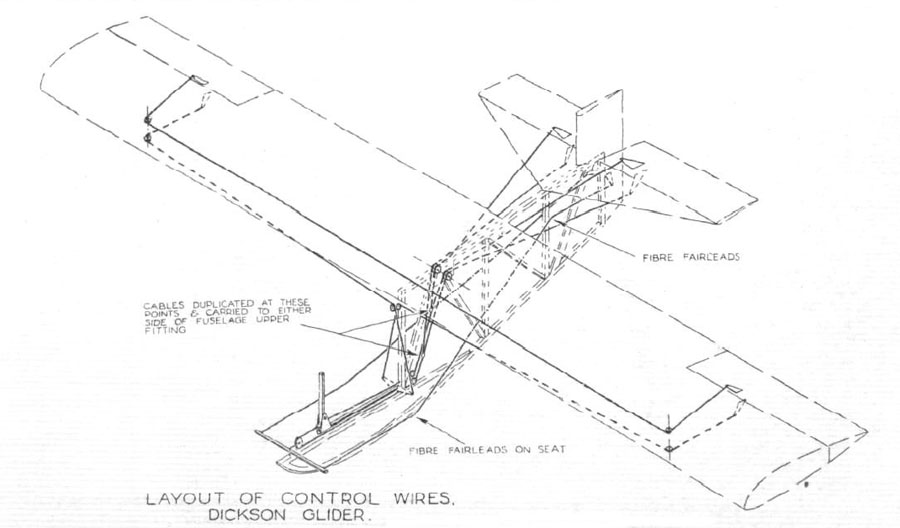 F-10 - The Dickson glider : As promised last week we show above a diagrammatic layout of the control wires.
[Flight 30 mai 1930, pages 587] [1930-0619] 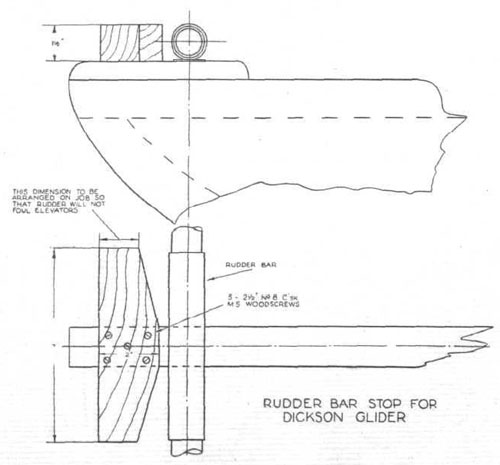 F-11 - A further detail drawing for the Dickson Glider which completes the series for the controls.
[Flight 22 août 1930, pages 957] [1930-1005] We are informed that the designer of this glider has carried out extensive flight trials, and the machine behaved beautifully in every way, proving exceptionally stable. The only slight adjustment made was to fit the wires inside the rudder pedals instead of outside, to slightly reduce the gearing. [Flight 10 octobre 1930, pages 1117] [1930-1181] Constructors of the Dickson glider, plans for which are obtainable from this office, will be interested to hear that this glider has proved itself to be exceptionally good in high altitudes. The Germiston Flying Club have built one, and although a great deal of scepticism was evident in the criticisms offered by the local "experts," who averred that no glider would function satisfactorily in the district with the altitude over 6,000 ft. above sea level, the first trials fully bore out their faith in the design and many good flights have been made, and this in spite of the fact that flying conditions were bad even for that district. There was little wind and the atmosphere was super-heated ! There are now many gliders of this type being built all over the world, and it has proved admirable for training purposes. Further details of the plans are given in our advertisement columns. 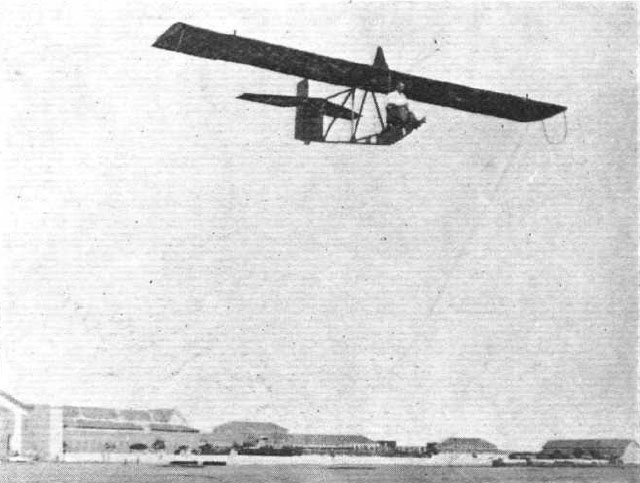 F-12 - The Dickson type glider, designed, built and flown by airmen of the R.A.F. Depot (Karachi). L.A/C. Eville manages 40 ft. from level aerodrome. 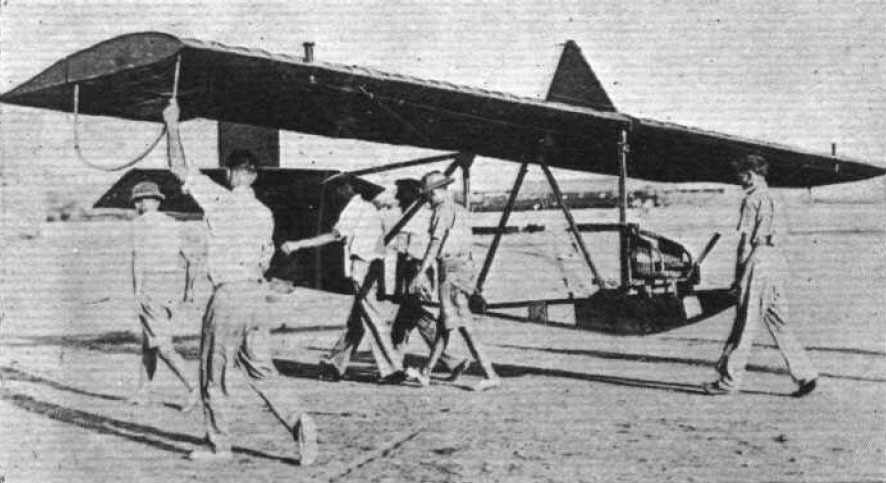 F-13 - Another view of the Karachi-built glider, which has been called the "Desert Fowl” STOCKPORT Gliding Club.—At a further meeting of the above club held in Crossley's Cafe, on November 11, further plans were discussed re the building of the glider. Since the last meeting, the blue prints of the Dickson glider had been secured and an interesting time was spent by the members in looking these over. The next resolution was to appoint someone at the head of the constructional section who would be capable of taking charge. It was unanimously agreed that Mr. Walton be appointed chairman of the constructional section. Also, in order that a start may be made on the glider as soon as possible, it was resolved that prices of certain raw material which would be wanted be obtained. It was further resolved to accept Mr. Walton's kind offer of a room in his premises at the Wellington Garage be accepted, and to make this the headquarters for the time being at any rate. Another resolution put forward was that they should try and get in touch with the Manchester branch of the Royal Aeronautical Society with a view to the interchanging of ideas and suggestions. The secretary was requested to try and make such an arrangement for the members to go over and view their glider. To anyone interested, further details will gladly be supplied upon application to the Secretary, J. T. L. Mallard, The Radio House, Sandy Lane, Stockport. (Tel. 3445.) [Flight 28 novembre 1930, pages 1391] [1930-1469] STOCKPORT Gliding Club are considering ways and means of securing a room in which they may construct their own glider, during the coming winter. Members will find plenty of work of an interesting nature to keep them quiet during the winter evenings, in constructing this machine. This is an exceptionally good way of retaining that first flush of enthusiasm with which such clubs are formed, during that difficult period when both weather and finance makes gliding and the acquisition of a machine a matter which has to be deferred. By building their own machine they will be able to obtain it at a very much cheaper rate than otherwise, and, moreover, will have acquired a large amount of exceedingly valuable experience in construction, which will stand them in good stead for their consequent inevitable repairs. When this Dickson type has been finished, it is proposed to proceed with a secondary or Priifling type, so that by next spring members who are then efficient in gliding will be able to start soaring. [Flight 12 décembre 1930, pages 1391] [1930-1441]  F-14 - Home construction : A view of the Dickson glider built by the Aircraft Club, Harrogate, from "Flight" drawings "The Aircraft Club, HARROGATE, has completed its first year of working, and it may interest other clubs to know that very few members paid more than 10s. subscription, yet it was able to finish the first year with a small credit balance in hand. Furthermore, this is probably the only club which first of all started with a constructional section for its members. They built their first glider, a Dickson type training glider, and the experience gained with this, together with the talent they have available, has enabled them to cope with all repairs themselves. The annual general meeting was held in the clubroom on January 16, with Mr. Woodmansey in the chair. The first glider was completed and taken to Healthwaite Hill on November 15 and successfully flown and meetings have been held there every Sunday since that date. Over 115 flights have been made in this machine in winds of from 1 to 40 m.p.h. [Flight 27 février 1931, pages 189] [1931-0205] THE ASSOCIATION OF NORTHERN GLIDING CLUBS have had several successful week-ends recently, in spite of much rain and snow. Even in high winds they have found that their experienced pilots are able to make good use of their Dickson glider, and many landings have been made back on top of the hill, which makes pilots who do this very popular with the launching crews. The new " Rhön- Ranger," designed by Mr. Sutton, has been tested and found to be very successful. The clubs' experience is that their more advanced pilots prefer a day when the wind is at least 30 m.p.h. They do not allow anyone to take a machine up when the wind exceeds 15 m.p.h. until he is really expert, and they always instruct pilots to put the stick right forward directly the machine lands, as this tends to hold the nose of the glider down on the ground until help arrives and prevents the glider being blown over. [Flight 6 mars 1931, pages 203] [1931-0219]  F-15 - The New Zealand built Dickson Glider at Wanganui. [Flight 10 avril 1931, pages 316] [1931-0340]
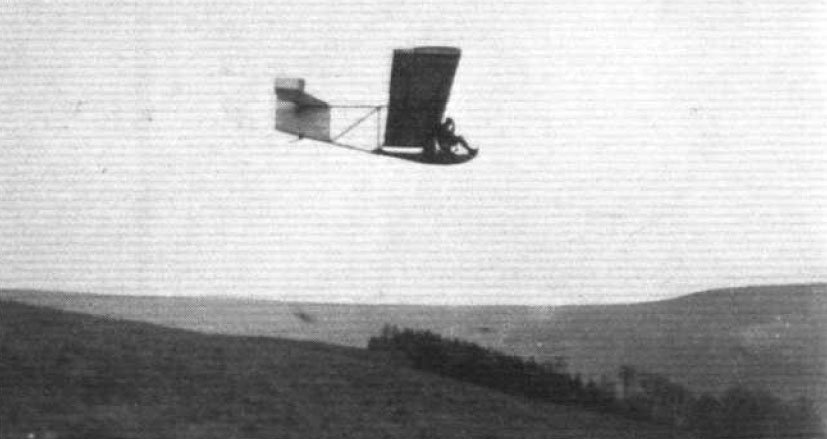 F-16 - The Dickson glider built by the Aircraft Club, Harrogate. [Flight 1 janviel 1932, page 10] [1932-0008]
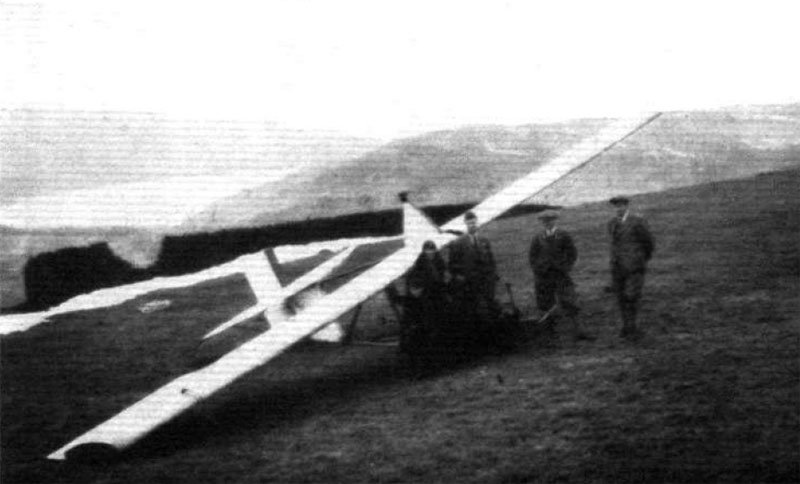 F-17 - GLIDING COUNTRY: (Left to right), Mrs.Addyman and " the boys," N . Pickles, L. Brook, E. W. Addyman. From this slope flights of over a mile have been made in the " Dickson " glider built by the Aircraft Club of Harrogate. [Flight 12 février 1932, page 132] [1932-0140]
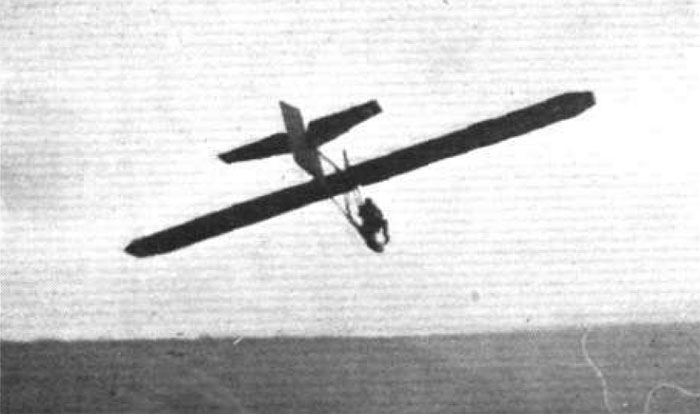 F-18 - Modified Dickson Glider built by the Aircraft Club, Harrogate, soaring over the Hole of Horcaun, near Saltersgate. |
|
| RÉFÉRENCES On trouvera les articles sous forme de pages en format PDF dans les archives en ligne de la revue Flight, sur le site Flightglobal/Archiv . | |
 Page
mise à jour le 04/10/2010 Page
mise à jour le 04/10/2010 |
| Des vieilles toiles aux planeurs
modernes © ClaudeL 2003 -
|